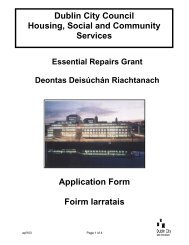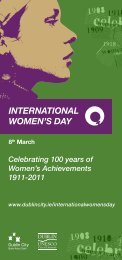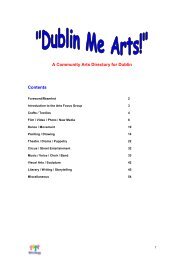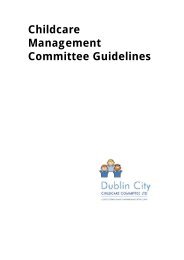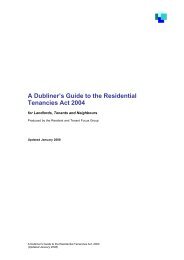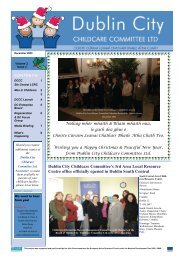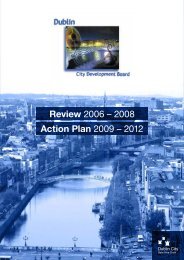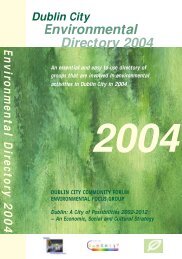THE DUBLIN TOWN HOUSE - Dublin.ie
THE DUBLIN TOWN HOUSE - Dublin.ie
THE DUBLIN TOWN HOUSE - Dublin.ie
Create successful ePaper yourself
Turn your PDF publications into a flip-book with our unique Google optimized e-Paper software.
<strong>THE</strong> <strong>DUBLIN</strong> <strong>TOWN</strong> <strong>HOUSE</strong><br />
To mark the publication of The Eighteenth-Century <strong>Dublin</strong> Town House, Dr. Christine Casey,<br />
editor and contributor to the publication will present a lunchtime lecture entitled<br />
PLAIN POMP: <strong>THE</strong> EIGHTEENTH-CENTURY <strong>DUBLIN</strong> <strong>TOWN</strong> <strong>HOUSE</strong><br />
THURSDAY 21ST OCTOBER , 1PM - 2PM<br />
WOOD QUAY VENUE, CIVIC OFFICES, WOOD QUAY, <strong>DUBLIN</strong> 8.<br />
ALL ARE WELCOME. ATTENDANCE IS FREE.<br />
Four Courts Press
<strong>THE</strong> EIGHTEENTH-CENTURY<br />
<strong>DUBLIN</strong> <strong>TOWN</strong> <strong>HOUSE</strong><br />
CHRISTINE CASEY, editor<br />
This volume draws together the disciplines of architecture, history<br />
and art history to produce a multi-faceted picture of the eighteenthcentury<br />
city dwelling. Discussion includes the financing of speculative<br />
development, the sourcing and working of building materials and the<br />
decoration of house interiors by master craftsmen. The lives lived in<br />
these houses are also illuminated by essays on house contents, on the<br />
taxes paid by house occupants and on the v<strong>ie</strong>ws or prospects which,<br />
as today, were often the subject of dispute. A dinner book of the mid<br />
eighteenth century records in remarkable detail the sumptuous and<br />
exotic meals enjoyed in these houses while nineteenth-century records<br />
evoke the deprivation suffered by tenement dwellers.<br />
This illustrated public lecture will present an overv<strong>ie</strong>w of the<br />
eighteenth-century <strong>Dublin</strong> house, its builders, occupants and physical<br />
form.
<strong>THE</strong> EIGHTEENTH-CENTURY<br />
<strong>DUBLIN</strong> <strong>TOWN</strong> <strong>HOUSE</strong>:<br />
FORM, FUNCTION & FINANCE<br />
1. Niall McCullough The <strong>Dublin</strong> house<br />
2. Brendan Twomey Financing speculative property<br />
development in early eighteenthcentury<br />
<strong>Dublin</strong><br />
3. Christine Casey The <strong>Dublin</strong> domestic formula<br />
4. Robin Usher Domestic Architecture, the old city,<br />
and the suburban challenge, c.1660-<br />
1700<br />
5. Susan Roundtree Brick in the eighteenth-century<br />
<strong>Dublin</strong> town house<br />
6. Tony Hand Supplying stone for the <strong>Dublin</strong><br />
house<br />
7. Finola O’Kane 'Bargains in V<strong>ie</strong>w': The Fitzwilliam<br />
family's development of Merrion<br />
Square<br />
8. Patricia McCarthy From parlours to pantr<strong>ie</strong>s:<br />
inventor<strong>ie</strong>s and the eighteenthcentury<br />
<strong>Dublin</strong> interior<br />
9. Alison FitzGerald 'Taste in High Life': dining in the<br />
<strong>Dublin</strong> townhouse<br />
10. Edward McParland The geometry of the stable lane
11. Sarah Rhiannon Drumm ‘Fine Rooms Increase Wants’: town<br />
houses of Irish MPs<br />
12. Jacinta Prunty The town house as tenement in<br />
nineteenth- and early twent<strong>ie</strong>thcentury<br />
<strong>Dublin</strong><br />
13. Loreto Calderón & New light on Hugh Montgomer<strong>ie</strong>,<br />
Konrad Dechant Richard Castle and Number 85<br />
Saint Stephen’s Green<br />
14. John Montague Leitrim House: a re-assessment<br />
15. Lynda Mulvin Charlemont’s neighbours: Coláiste<br />
Mhuire, Parnell Square in context<br />
16. Joseph McDonnell Patrons and plasterers: the origin of<br />
<strong>Dublin</strong> rococo stuccowork<br />
17. Conor Lucey Classicism or commerce? The<br />
townhouse interior as commodity<br />
18. Peter Guillery Plan form: Some comparative<br />
thoughts from London<br />
19. Alistair Rowan The town house in the capital of<br />
North Britain
<strong>THE</strong> EIGHTEENTH-CENTURY<br />
<strong>DUBLIN</strong> <strong>TOWN</strong> <strong>HOUSE</strong>:<br />
Contributors<br />
Toby Barnard has been fellow and tutor in history at Hertford College, Oxford, since 1976. His<br />
recent books include A new anatomy of Ireland (2003); Making the Grand Figure: lives and possessions in<br />
Ireland, 1641-1700 (2004) and Improving Ireland? Projectors, prophets and profiteers, 1641-1786 (2008). He<br />
is a fellow of the British Academy and an honorary member of the Royal Irish Academy. Between<br />
2006 and 2009 he held a Leverhulme senior research fellowship, working on the cultures of print<br />
in Ireland between 1680 and the 1790s<br />
Niall McCullough stud<strong>ie</strong>d architecture in UCD and works as a director of McCullough Mulvin<br />
Architects. He is interested in research, teaching and building and is the author or co-author of a<br />
number of books and articles on <strong>Dublin</strong> and on Irish architecture.<br />
Brendan Twomey has been a banker in <strong>Dublin</strong> for over thirty years. His published works include<br />
Smithf<strong>ie</strong>ld and the parish of St Paul. 1695-1750 (2005) and <strong>Dublin</strong> in 1707, a year in the life of the city<br />
(2009), both in the Maynooth Stud<strong>ie</strong>s in Local History ser<strong>ie</strong>s. Current research projects include a<br />
biographical essay on the antiquarian and historian Francis Elrington Ball and a study of the visual<br />
representation of the Salmon Leap falls in Leixlip over the past three centur<strong>ie</strong>s.<br />
Christine Casey is a senior lecturer in architectural history in the Department of the History of<br />
Art and Architecture at Trinity College. She has written widely on the history of Irish architecture<br />
and is author and co-author of two volumes in the Buildings of Ireland ser<strong>ie</strong>s, North-Leinster (1993)<br />
and <strong>Dublin</strong> (2005).<br />
Robin Usher is a researcher at the University of Oxford. He stud<strong>ie</strong>d at Trinity College, <strong>Dublin</strong>,<br />
and Cambridge University, where he received a PhD for a thesis on <strong>Dublin</strong>’s political iconography<br />
in the period 1660-1760. A book on the same topic, published by Palgrave Macmillan, is in press.<br />
Susan Roundtree stud<strong>ie</strong>d architecture at the <strong>Dublin</strong> Institute of Technology. She completed the<br />
Master of Urban & Building Conservation (UCD) in 1992 and obtained a Master of Letters<br />
(TCD) in 1999 for research on the history of brickwork in Ireland. She is a senior architect with
<strong>Dublin</strong> City Council, and an accredited Conservation Architect (RIAI). She is co-author, with<br />
Gerard Lynch and Shaffrey Associates, of the Advice Ser<strong>ie</strong>s publication on the repair of historic<br />
brickwork.<br />
Tony Hand is employed as an engineer for a mining company. He is currently engaged in<br />
research at Trinity College <strong>Dublin</strong> for a PhD on the Colles family and the Kilkenny marble works.<br />
He has recently published several related articles in Irish architectural and decorative stud<strong>ie</strong>s.<br />
Finola O’Kane is a lecturer in architecture and conservation in the School of Architecture,<br />
Landscape and Civil Engineering, University College <strong>Dublin</strong>. She is author of Landscape design in<br />
eighteenth-century Ireland (2004) and joint editor of Georgian Ireland (2008).<br />
Patricia McCarthy is an architectural historian and author of ‘A favourite study’: building the King’s<br />
Inns (2006). She has published numerous essays on eighteenth- and nineteenth-century Irish<br />
architecture.<br />
Alison FitzGerald lectures in the Department of History at NUI Maynooth. She specializes in<br />
design history, in particular the history of goldsmiths, jewellers and all<strong>ie</strong>d traders.<br />
Edward McParland is a fellow emeritus of Trinity College <strong>Dublin</strong> where he has lectured in the<br />
Department of the History of Art since 1973. He published James Gandon, Vitruvius Hibernicus in<br />
1985, and Public architecture in Ireland, 1680-1760 in 2001. With Nicholas Robinson he founded the<br />
Irish Architectural Archive<br />
Sarah Rhiannon Drumm completed an MA (NUI <strong>Dublin</strong>) in 2002 on the pastel artist Rosalba<br />
Carr<strong>ie</strong>ra, before going on to complete an MLitt (NUI <strong>Dublin</strong>) in 2007 on the eighteenth-century<br />
<strong>Dublin</strong> townhouse. She is currently working in Christ Church Cathedral.<br />
Jacinta Prunty is a senior lecturer in the Department of History, NUI Maynooth. She has<br />
published in the f<strong>ie</strong>lds of map history, slum geography, and the history of religious congregations<br />
and city missions; she is co-ordinator of the MA in Historical Archives now offered by the<br />
Department of History.<br />
Loreto Calderón holds an MA in the history of art from UCD (2008) and was research assistant<br />
for the <strong>Dublin</strong> volume in the Buildings of Ireland ser<strong>ie</strong>s. She now conducts independent research on<br />
aspects of Irish and European art history.<br />
Konrad Dechant has worked in Newman House, St. Stephen’s Green, <strong>Dublin</strong> for the last ten
years under the curator Ruth Ferguson. He took Greek and Biblical Stud<strong>ie</strong>s at Trinity College,<br />
<strong>Dublin</strong>, and has an MPhil from TCD.<br />
John Montague is currently working on the Royal Irish Academy Art and Architecture of Ireland<br />
project, Volume IV, Architecture 1600-2000. He has recently completed a PhD at the Department of<br />
the History of Art and Architecture, Trinity College, on the subject of John Rocque’s Exact Survey<br />
of <strong>Dublin</strong>, 1756. He has worked on conservation plans for historic buildings in <strong>Dublin</strong> and<br />
elsewhere and has published on a wide range of Irish architectural topics from med<strong>ie</strong>val cloisters to<br />
the modernist <strong>Dublin</strong> suburb of Ballymun.<br />
Lynda Mulvin is a lecturer in the School of Art History and Cultural Policy, UCD. She has a<br />
specialist background and interest in classical antiquity and architectural history. She is currently<br />
working on C.R. Cockerell and neo-classicism.<br />
Joseph McDonnell has written on the fine and decorative arts including Irish eighteenth-century<br />
stuccowork and its European sources (1991), Art of the penal era (1995) and 500 years of the art of the book in<br />
Ireland (1997). He is currently completing a study of the destroyed book-bindings of the manuscript<br />
journals of the eighteenth-century Irish parliament with a detailed catalogue of the individual tools.<br />
Conor Lucey is the author of The Stapleton Collection: designs for the Irish neo-classical interior (2007), a<br />
study of the eighteenth-century <strong>Dublin</strong> stuccodore Michael Stapleton. He has recently been<br />
appointed editor of the Irish Architectural and Decorative Stud<strong>ie</strong>s, the journal of the Irish Georgian<br />
Soc<strong>ie</strong>ty.<br />
Peter Guillery is a Senior Historian for the Survey of London, which continues from within<br />
English Heritage. His books on London’s buildings include The small house in eighteenth-century London<br />
(2004) and (with Neil Burton) Behind the Façade, London House Plans 1660-1840 (2006).<br />
Alistair Rowan trained as an architect in Edinburgh and taught for ten years in the Department<br />
of Fine Art in Edinburgh University during which time he served as a member of the Edinburgh<br />
New Town Conservation Committee advising the Secretary of State for Scotland on the protection<br />
and future of the Georgian city. He was appointed professor of the History of Art in UCD in 1977<br />
and Slade professor of art in Oxford in 1988, when he lectured on the architecture of Robert<br />
Adam. In 1990 he returned to Edinburgh as Principal of the College of Art. He also set up the<br />
Department of the History of Art in UCC between 2001 and 2003 and now lives in retirement in<br />
central <strong>Dublin</strong>.



